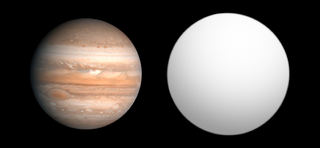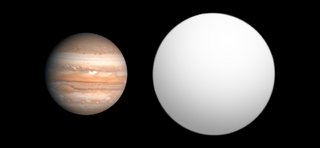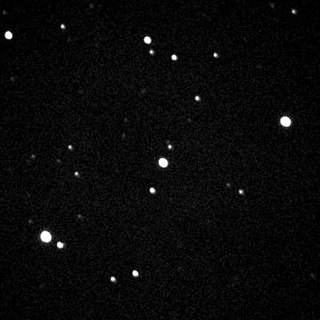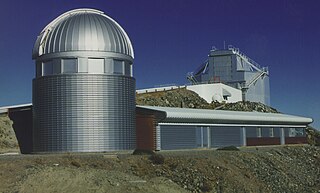
TrES-1b is an extrasolar planet approximately 523 light-years away in the constellation of Lyra. The planet's mass and radius indicate that it is a Jovian planet with a similar bulk composition to Jupiter. Unlike Jupiter, but similar to many other planets detected around other stars, TrES-1 is located very close to its star, and belongs to the class of planets known as hot Jupiters. The planet was discovered orbiting around GSC 02652-01324.

Hot Jupiters are a class of gas giant exoplanets that are inferred to be physically similar to Jupiter but that have very short orbital periods. The close proximity to their stars and high surface-atmosphere temperatures resulted in their informal name "hot Jupiters".

WASP or Wide Angle Search for Planets is an international consortium of several academic organisations performing an ultra-wide angle search for exoplanets using transit photometry. The array of robotic telescopes aims to survey the entire sky, simultaneously monitoring many thousands of stars at an apparent visual magnitude from about 7 to 13.

XO-1 (Moldoveanu) is a magnitude 11 G-type main-sequence star located approximately 530 light-years away in the constellation Corona Borealis. XO-1 has a mass and radius similar to the Sun. In 2006 the extrasolar planet XO-1b was discovered orbiting XO-1 by the transit method using the XO Telescope.

XO-1b is an extrasolar planet approximately 536 light-years away from Earth.

TrES-2b is an extrasolar planet orbiting the star GSC 03549-02811 located 750 light years away from the Solar System. The planet was identified in 2011 as the darkest known exoplanet, reflecting less than 1% of any light that hits it. Reflecting less light than charcoal, on the surface the planet is said to be pitch black. The planet's mass and radius indicate that it is a gas giant with a bulk composition similar to that of Jupiter. Unlike Jupiter, but similar to many planets detected around other stars, TrES-2b is located very close to its star and belongs to the class of planets known as hot Jupiters. This system was within the field of view of the Kepler spacecraft.

HAT-P-1b is an extrasolar planet orbiting the Sun-like star HAT-P-1, also known as ADS 16402 B. HAT-P-1 is the dimmer component of the ADS 16402 binary star system. It is located roughly 521 light years away from Earth in the constellation Lacerta. HAT-P-1b is among the least dense of any of the known extrasolar planets.

Any planet is an extremely faint light source compared to its parent star. For example, a star like the Sun is about a billion times as bright as the reflected light from any of the planets orbiting it. In addition to the intrinsic difficulty of detecting such a faint light source, the light from the parent star causes a glare that washes it out. For those reasons, very few of the exoplanets reported as of January 2024 have been observed directly, with even fewer being resolved from their host star.

WASP-1b is an extrasolar planet orbiting the star WASP-1 located 1,300 light-years away in the constellation Andromeda.

WASP-1 is a metal-rich magnitude 12 star located about 1,250 light-years away in the Andromeda constellation.
WASP-2 is a binary star system in the Delphinus constellation located about 500 light-years away. The primary is magnitude 12 orange dwarf star, orbited by red dwarf star on wide orbit. The star system shows an infrared excess noise of unknown origin.

CoRoT-2b is the second extrasolar planet to be detected by the French-led CoRoT mission, and orbits the star CoRoT-2 at a distance of 700 light years from Earth towards the constellation Aquila. Its discovery was announced on 20 December 2007. After its discovery via the transit method, its mass was confirmed via the radial velocity method.
This page describes exoplanet orbital and physical parameters.

WASP-14b is an extrasolar planet discovered in 2008 by SuperWASP using the transit method. Follow-up radial velocity measurements showed that the mass of WASP-14b is almost eight times larger than that of Jupiter. The radius found by the transit observations show that it has a radius 25% larger than Jupiter. This makes WASP-14b one of the densest exoplanets known. Its radius best fits the model of Jonathan Fortney.

CoRoT-3b is a brown dwarf or massive extrasolar planet with a mass 21.66 times that of Jupiter. The object orbits an F-type star in the constellation of Aquila. The orbit is circular and takes 4.2568 days to complete. It was discovered by the French-led CoRoT mission which detected the dimming of the parent star's light as CoRoT-3b passes in front of it.

OGLE-TR-111b is an extrasolar planet approximately 5,000 light-years away in the constellation of Carina. The planet is currently the only confirmed planet orbiting the star OGLE-TR-111.

Leonhard Euler Telescope, or the Swiss EULER Telescope, is a national, fully automatic 1.2-metre (47 in) reflecting telescope, built and operated by the Geneva Observatory. It is located at an altitude of 2,375 m (7,792 ft) at ESO's La Silla Observatory site in the Chilean Norte Chico region, about 460 kilometers north of Santiago de Chile. The telescope, which saw its first light on 12 April 1998, is named after Swiss mathematician Leonhard Paul Euler.

GSC 03549-02811 is a binary star containing a yellow main-sequence star similar to the Sun. This star is located approximately 750 light-years away in the constellation of Draco. The apparent magnitude of this star is 11.41, which means it is not visible to the naked eye but can be seen with a medium-sized amateur telescope on a clear dark night. The age of this star is about 5 billion years.

An exoplanet is a planet located outside the Solar System. The first evidence of an exoplanet was noted as early as 1917, but was not recognized as such until 2016; no planet discovery has yet come from that evidence. What turned out to be the first detection of an exoplanet was published among a list of possible candidates in 1988, though not confirmed until 2003. The first confirmed detection came in 1992, with the discovery of terrestrial-mass planets orbiting the pulsar PSR B1257+12. The first confirmation of an exoplanet orbiting a main-sequence star was made in 1995, when a giant planet was found in a four-day orbit around the nearby star 51 Pegasi. Some exoplanets have been imaged directly by telescopes, but the vast majority have been detected through indirect methods, such as the transit method and the radial-velocity method. As of 24 July 2024, there are 7,026 confirmed exoplanets in 4,949 planetary systems, with 1007 systems having more than one planet. This is a list of the most notable discoveries.

The Next-Generation Transit Survey (NGTS) is a ground-based robotic search for exoplanets. The facility is located at Paranal Observatory in the Atacama desert in northern Chile, about 2 km from ESO's Very Large Telescope and 0.5 km from the VISTA Survey Telescope. Science operations began in early 2015. The astronomical survey is managed by a consortium of seven European universities and other academic institutions from Chile, Germany, Switzerland, and the United Kingdom. Prototypes of the array were tested in 2009 and 2010 on La Palma, and from 2012 to 2014 at Geneva Observatory.


















